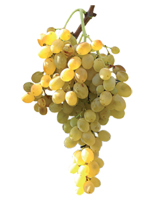
Zibibbo, a story of Sicilian identity
- Letto 27208 volteZibibbo is one of the rarest grapes in the world with a triple attitude: it is a wine grape, a table grape and a raisin grape. Its extraordinary adaptability is the main reason for a long history that dates back 5.000 years.
The Zibibbo has been cultivated in the Mediterranean area since immemorial times, and has crossed hundreds of centuries without significant genetic modifications.
 The scientific name of Zibibbo is Muscat of Alexandria: the name itself suggests that this grape variety was cultivated in ancient Egypt, either after being imported there or indigenously developed from trade contacts between the populations of the Fertile Crescent area.
The scientific name of Zibibbo is Muscat of Alexandria: the name itself suggests that this grape variety was cultivated in ancient Egypt, either after being imported there or indigenously developed from trade contacts between the populations of the Fertile Crescent area.
Archaeological evidence suggests that winemaking existed during the Egypt’s first dynasty (3000-2890 B.C.) and greatly developed throughout time, as this beautiful picture found in the Tomb of Kakht at Thebes demonstrates.

Zibibbo was later brought to Sicily and other colonies by the Phoenicians (in red) and the Greeks (in blue) and became one of the most interesting varieties of Western Mediterranean around the 800-700 B.C.
During the Roman Empire, the variety managed to make its way to Northern European regions (in green).


Rather than being called Muscat of Alexandria, this ancient grape is known in Sicily mainly with its Arabic appellation, Z’bīb, which simply means “dried grape" or "raisin”.
The legend says that the Zibibbo was the grape that easier than others survived the Arabic domination: the Sicilian Arabs had the right to grow this vine for making raisins to enrich their super tasty culinary preparations, but did not disdain to make and drink good wine.
Wine consumption was actually forbidden for religious principles, but widely tolerated at that times: this beautiful illustration kept in the Salinas Museum in Palermo portrays "The Zibibbo Tavern”, and wine is the subject of numerous medieval Arabic poems.
Zibibbo: geographic distribution
This grape grows today not only in Sicily, but also in different European Countries as well as in South Africa, California, Australia, and South America, with over 200 synonyms registered.
The most part of the Sicilian Zibibbo is cultivated in the province of Trapani. Pantelleria, a small island in the middle of the Mediterranean, has become part of the UNESCO World Heritage for the traditional viticulture methods still used for the vines’ training.
Characteristics of Zibibbo
Zibibbo is one of the few existing aromatic wine grapes. Like Gewürztraminer, Riesling and Sauvignon Blanc, its berries contain high levels of organic compounds called terpenes. Zibibbo, in particular, has a super concentration of linalool, geraniol and nerol, all of them responsible for the wines' intense aromas.
It is a resilient variety: while sensitive to extreme humidity, it is resistant to drought and hot climates, and that’s why recent studies suggest that Zibibbo is among the most interesting varieties to consider in an era of climate change.
Zibibbo: tasting notes
Due to its long history of adaption to different terroirs, the Zibibbo has a great intra-varietal genetic variability. That means that its clones show distinctive characters that change from place to place.
Two main biotypes have been identified in Sicily.
 Biotype A produces golden-yellow loose bunches. Its grapes have higher alcohol potential and milder acidity, and can be successfully used for making wines with solid structure and great longevity.
Biotype A produces golden-yellow loose bunches. Its grapes have higher alcohol potential and milder acidity, and can be successfully used for making wines with solid structure and great longevity.
Biotype B has green berries and a medium compact bunch. Its wines generally have a lower alcohol level, a higher acidity, and a thinner structure.
Being Zibibbo a triple attitude variety, the wines can be incredibly different and unique.
From light dry wines that show a nose of white flowers and citrus fruit, to more intense orange wines with a stunning palate of figs, apricot and candied orange peel, to complex dessert wines with dominant honey, dates and nuts, a Zibibbo tasting is always a fascinating experience.
Serving tips and food pairing
The most appropriate glass for Zibibbo depends on the wine’s structure. A regular white wine glass is perfect for light and crispy wines, while a large glass with a wide opening is more suitable for richer orange wines. A tulip shaped glass is the best choice to appreciate the complex aromas of a passito.
Pairing Zibibbo with food is easy, and always very successful: from fish and seafood to white meat, to a wide range of matured cheese, the perfect combination will depend more on the wine’s style than just on the varietal. Furthermore, considering that many Zibibbo wines can age for 10+ years, the best way to find great pairings is personal, enthusiastic research.
WINE SHEETS
 |
MORE RESOURCES ON ZIBIBBO
![]() Want to know more about Zibibbo?
Want to know more about Zibibbo?
Watch and download the complete infographic by clicking on the picture.
Feel free to use any of the information and pictures included in this article for your studies or presentations, by citing the source.
Want to share this article or the infographic?
Please tag your posts with #SicilianWine, it will be easier for you to follow all interactions on Facebook and Twitter.
Tags: #SicilianWine, zibibbo, infografica, sicilian grape varieties






